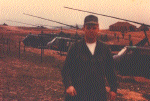NOTE: This article is a condensed version of several sources and viewpoints that may conflict with other sources. For a complete factual account of operation "Lamar Plain", please refer to "After Action Report on Operation Lamar Plain" filed 15 Sept 1969, by Col. Frank L. Deitrich, the commanding officer of the 1st Brigade of the 101st Airborne Division (AMBL) |


|
The brigade’s new mission was to discontinue its screening operations near the Laotian boarder and its security operations along Route 1 from Hue to Da Nang. It was to move south to the Chu Lai-Tam Ky area and, under the operational control of the Americal Division, find and defeat the enemy. Assets attached to the 1st Brigade for the operation included two infantry battalions, an air cavalry (B Troop, 2nd Squadron, 17th Air Cavalry Regiment) troop, an aerial rocket artillery battery, a 105mm artillery battery, a company of UH-1 Hueys and a section of CH-47 Chinooks. The brigade’s aviation platoon included the aeroscout section - Hughes OH-6A Cayuse light observation helicopters (LOHs), better known as “Loachs”- armed with 7.65mm miniguns; also attached to brigade headquarters was a section of U.S. Air Force forward air controllers (FACs). By noon on May 15, 1969, elements of the 101st Airborne were in combat west of Tam Ky; B Troop 2/17 Cav was operating pink teams to verify the briefing they had received from Americal personnel. First Brigade pilots were briefed by pilots of the 71st Assault Helicopter Company - the “Rattlers” (the lift crew) and the “Firebirds” (the gun crew). The Americal’s Division area of operations (A/O) was the largest and, in some ways, the most difficult in South Vietnam. Although Americal was numerically one of the largest U.S. divisions, it lacked the helicopter assets of the 101st Airborne Division. The terrain offered several advantages to the enemy. In extreme northern I Corps, the villages and friendly population hugged the thin coastal strip; anyone in the mountains was the enemy. In the area west of Tam Ky, the terrain was gently rolling with open areas and friendly villages interspersed with low jungle. This afforded the Northern Vietnamese Army (NVA) rapid movement, easy resupply, and some protection when in or near friendly villages. The A/O for the 1st Brigade would be roughly an oblong shaped area from east of Tam Ky to the village of Tien Phouc toward the west. Most of this landscape consisted of a valley formed by a lone mountain on the west (later called Recon Zone Alpha), a river meandering north and south near Phouc to the west, and low ridges forming the north and south boundaries. Helicopter crews said this place was called “Death Valley.” FSB Professional was located on a small rise on the valley floor, with higher ridges to the north and south. Enemy pressure on the landing zone was so great that resupply was in danger of being cut off. Several days earlier, a CH-47 Chinook had been destroyed by recoilless rifle tire while it hovered over the helipad - in daylight. The day before the alert was issued, a company-sized infantry team had left FSB Professional on foot to sweep the immediate area. Only a handful of the team members had returned; the opposition had been so fierce that the dead and wounded had been left behind. It was thought that grunts had run into the main body of the 2nd North Vietnamese Army (NVA) Regiment. The S-2 (military intelligence) officer believed that the NVA regiment was reinforced with an anti aircraft battalion equipped with 12.7mm machine guns. Roughly equivalent to American .50-caliber M-2 machine guns, these weapons were sometimes referred to as “.51’s.” The first mission of the brigade aeroscouts was to find the site where the infantry team had been lost, locate the enemy, and look for American survivors. Probing the foothills northwest of FSB Professional, the brigade scouts in their small LOHs began investigating trails and hooches made of bamboo and thatch, experiencing sporadic automatic-weapons fire at every turn. The mission was different from what they had experienced up north. There, the scouts had had to do a lot of snoop-ing to get the bad guys to fire at them. They had to hover down trails, follow footprints to hideouts, and sometimes even use their aircraft’s rotor wash to blow camouflage away in order to find the bad guys. Up north it was rare for only one or two weapons to open up, troops were more likely to run into a heavy volume of disciplined fire. Here, however, it seemed that the NVA gunners on the ground were trying to swat gnats away—a few bursts of fire and perhaps the pests would fly away. One NVA gunner would fire from a hut, another from some nearby trail, and yet two more from a treeline. It was obvious that enemy troops did not perceive any real threat from the little choppers buzzing overhead. On the first day, the white team operated alone; the Cobras and the FACs were not yet available to the scouts. The scouts had to be content with returning fire, dropping a few fragmentation or white phosphorus grenades, marking their maps and waiting for tomorrow. Although happy to have found enemy.  the flight
line the flight
line  CO's B Model C&C CO's B Model C&C |